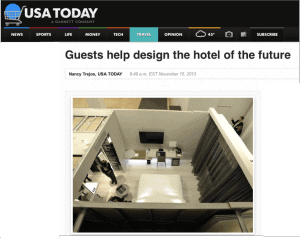A few weeks back, USA Today published an article that made me think of some of the approaches being used by hospitals under the banner of “Lean Design.” In Lean Design efforts (see this great book), hospitals involve customers (patients and families) to help iteratively design spaces that best suit their needs. Hotels are doing similar things:
“Guests help design the hotel of the future”
From the article:
[Hotels are] taking their cues from the people they want to please the most — their guests — as part of a new effort to “co-create” with their frequent travelers.
“It's really consumer-driven,” says Michael Dail, vice president of Global Brand Marketing for Marriott Hotels. “Rather than someone at the company coming up with the idea and letting consumers validate it, with co-creation the idea starts with the consumer.”
The old approach to hospital design involved architects and a small group of hospital leaders “coming up with the idea” and then letting patients and staff “validate” it after it was already built. Once a building is finished, it's too late, obviously, to make major changes (and sometimes, hospitals don't take input from patients or staff about little things that could improved).
The state of the art in hospital design is to “co-create” with patients and families (children's hospitals especially involve the families).
As somebody who stays in hotels A LOT (four different hotels this week), I appreciate a hotel room that's smartly designed. It's often the little things that matter, like the location of electrical outlets.
Hotels have always turned to focus groups to provide input on ideas and initiatives. But social media has empowered guests to let hotels know what they like and don't like in real time. Hotel companies are now responding to this more demanding traveler by including them in their design and development process in a much more collaborative way.
The co-creation process is far more collaborative than a focus group. In a focus group, ideas get written down and filtered. In co-creation, you're actually seeing prototypes of spaces and layouts – in a hospital or a hotel. I think the feedback and input is far more meaningful (again, if people are really willing to listen).
“For the longest time, hotel brands have followed the ‘closed' model of innovation by creating amenities in-house and force feeding them to guests,” says Chekitan Dev, an associate professor at Cornell University's School of Hotel Administration. “With an increasingly dynamic marketplace, and the emergence of a younger and more sophisticated travel consumer, this model no longer works.”
Hospitals are also shifting from that “closed model.” Maybe hotels will move faster on this front because there's so much more choice and competition?
Hospitals have been using full-size mockups, often in warehouse or parking garage space — now hotels are:
Consumer input was key in the redesign of InterContinental Hotels Group's Holiday Inn lobbies. IHG reached out to about 5,000 consumers for direction on the kind of food, design and amenities they wanted to see in the lobby. They took the best ideas and created a full-size mock-up of the “Active Lobby Concept” in a warehouse in Boston.
As hospitals are doing (and “Lean Startups are):
“It's learning what's most important to your customer and learning how to meet those needs,” Glickman says. “Our ideas have to come from the customer.”
Great stuff. Is your hospital doing more to involve patients, families, and staff in the design of new or renovated spaces?
Please scroll down (or click) to post a comment. Connect with me on LinkedIn.
Let’s build a culture of continuous improvement and psychological safety—together. If you're a leader aiming for lasting change (not just more projects), I help organizations:
- Engage people at all levels in sustainable improvement
- Shift from fear of mistakes to learning from them
- Apply Lean thinking in practical, people-centered ways
Interested in coaching or a keynote talk? Let’s talk.
Join me for a Lean Healthcare Accelerator Trip to Japan! Learn More











Good article. Kaiser has been doing this for a while. They engaged IDEO years ago in helping design patient-centered spaces. KP now has an innovation center where they can quickly prototype new space layouts and design. Great stuff.
Sound like a good concept, just sort of confused with the Holiday Inn lobbies attempt at this. If they took the best idea’s, then they are not really listening to what the consumers want, all they are doing is taking the few ideas they like from 5,000 consumer ideas. At least 1 out of 5,000 is going to be what the hotel wants, not necessarily what most of the consumers want.
Comments are closed.